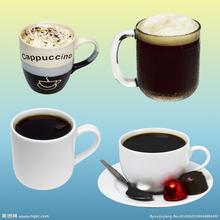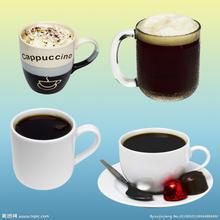Mexican coffee flavor taste manor producing area characteristics of boutique coffee introduction to Mexico's top coffee
The Teotihuacan civilization (Teotihuac á n) began around 200 BC, about in the middle of what is now Mexico, and was born after the demise of the Olmec civilization, about the same time as the Mayan civilization. the Teotihuacan people built a city of about 50,000 people between the first year of AD and 150, making it the earliest urban settlement in the whole American region, with many pyramids. However, unlike the genealogical context of other ancient Indian civilizations, the origin of the Teotihuacans is still an unsolved mystery, and no one can confirm that the civilization had written and documented it. Today, we know about the existence of this civilization, not only because they have left behind huge relics for analysis and proof, but also because some other surrounding civilizations of their time mentioned things about the Teotihuacans in their books or paintings. it's another key to reference. The Teotihuacans did not call themselves by this name, which was used by the Toltec, a successor civilization that existed in the region after the demise of the civilization, to call their predecessors the Nahuatl (a native Indian language of central Mexico), meaning "the land of man made by the gods". Although the ancient civilization disappeared long ago in the Toltek and even later Aztec times, they still regard the ancient city where the Teotihuacan once lived as a shrine, hence the name.
During the reign of Spain
In 1519, the Spanish invaded Mexico, and in 1521, Tenochtitl á n, the capital of Aztec, was conquered by the Tlaxcalteca, the main enemy of Spain and Aztec. But Spain did not completely conquer Aztec, but completed it two centuries later, and there are two main reasons for Spanish victory and Mexican enthusiasm and optimism, as reflected by the chocolates in Mexican coffee. There are different methods of Mexican coffee, but the main difference is whether it contains alcohol or not. let's first introduce the practice of non-alcohol. Heat a cup of milk, a teaspoon of cinnamon powder and a teaspoon of vanilla powder in a pot. Keep it at medium temperature. The heat is not too high. The milk must not boil. Then add the cocoa powder, fully dissolve and stir well. If you are particularly fond of chocolate, you can use chocolate paste instead of cocoa powder and milk. Let the milk dry for about 5 minutes, wait until the milk is slightly cool, then pour into the prepared coffee, decorate the coffee surface with cold cream, then decorate with a piece of cinnamon, and the Mexican coffee is ready. The aromas of chocolate and cinnamon blend together to give off the smell of desert. Tasting such a cup of coffee, you seem to be walking through the gray-green cactus in the Mexican desert. The most famous alcoholic drink in Mexico is tequila (Tequila). When Mexicans drink tequila, they lick a little salt on the tip of their tongue and then swallow the wine in a small glass. Tequila is a strong wine, the Mexican coffee made by adding this wine is very good, if you have enough courage, you might as well give it a try. Tequila Mexican coffee and non-alcoholic Mexican coffee is basically true, but first pour a small cup of tequila at the bottom of the cup, and then pour in milk and coffee, preferably decorated with cream and cinnamon

Important Notice :
前街咖啡 FrontStreet Coffee has moved to new addredd:
FrontStreet Coffee Address: 315,Donghua East Road,GuangZhou
Tel:020 38364473
- Prev

Costa Rican Yersalo Coffee with Light Flavor and Pure Taste
Costa Rica is exposed to natural disasters several times higher than other regions, but its arable area is more than enough to compensate. There are many kinds of coffee here, but its industrial policy is large and cheap, so there are not many excellent coffee, but it is a good choice to mix other coffees. One of the most famous is Mountain Costa Coffee, which tastes mellow and neutral.
- Next

Introduction to the flavor and taste of the balanced and soft El Salvador Himalayan Coffee Manor
El Salvador's coffee accounts for 40% of the country's exports, and it is usually picked in November, December and January-March of the following year. The export of raw beans lasts almost all year round. Coffee is produced in seven of the country's 14 provinces, with the largest number in the northwestern provinces of chalatenango and santa ana. The coffee produced in El Salvador is 100% Arabica, of which 68% is
Related
- Detailed explanation of Jadeite planting Land in Panamanian Jadeite Manor introduction to the grading system of Jadeite competitive bidding, Red bid, Green bid and Rose Summer
- Story of Coffee planting in Brenka region of Costa Rica Stonehenge Manor anaerobic heavy honey treatment of flavor mouth
- What's on the barrel of Blue Mountain Coffee beans?
- Can American coffee also pull flowers? How to use hot American style to pull out a good-looking pattern?
- Can you make a cold extract with coffee beans? What is the right proportion for cold-extracted coffee formula?
- Indonesian PWN Gold Mandrine Coffee Origin Features Flavor How to Chong? Mandolin coffee is American.
- A brief introduction to the flavor characteristics of Brazilian yellow bourbon coffee beans
- What is the effect of different water quality on the flavor of cold-extracted coffee? What kind of water is best for brewing coffee?
- Why do you think of Rose Summer whenever you mention Panamanian coffee?
- Introduction to the characteristics of authentic blue mountain coffee bean producing areas? What is the CIB Coffee Authority in Jamaica?

